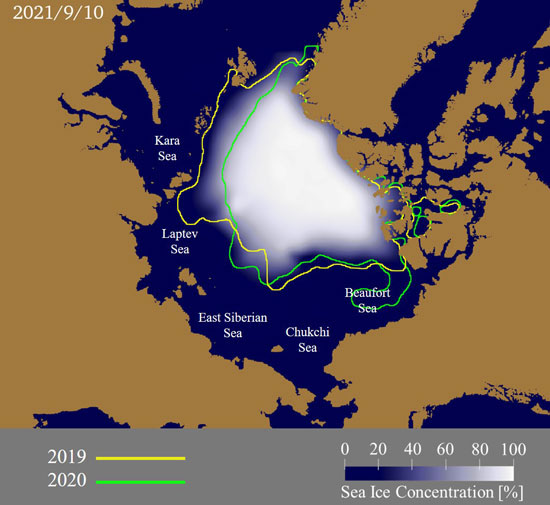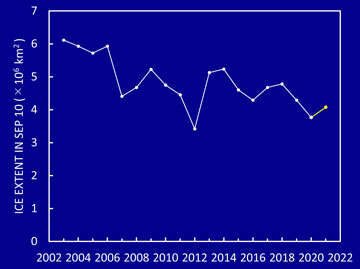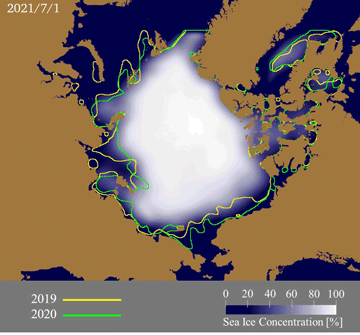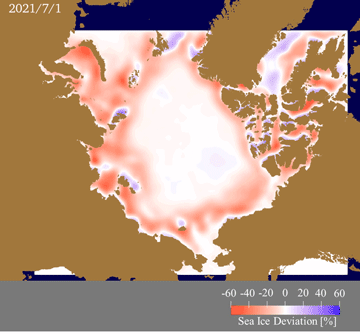2021 Second report
Arctic Sea Ice Information Center, Noriaki KIMURA (Atmosphere and Ocean Research Institute, The University of Tokyo)

- Minimum ice extent will be about 408 million square kilometers in September, larger than 2020 but smaller than 2019.
- The Northern Sea Route will open on around August 2, and the Canadian side except for Canadian archipelago will open on around July 15.
- Old ice spreads off Alaska in the Beaufort Sea and will possibly remain in September.


Yellow and green lines indicate the ice edge of the same day for 2019 and 2020.

This second report predicts sea ice extent after July 1 based on the sea ice condition at the end of May. The method is, the same as the first report, to track the movement of sea ice since December and calculation has been done for tracking period extended to the end of May. Additionally, the analysis of sea ice age distribution as of the end of May is made available in this report.
Sea ice extent on September 10 is predicted about 4.08 million square kilometers, which is smaller than 2019 but larger than 2020. It will be slightly smaller than 4.18 million square kilometers, as predicted in the first report. (The prediction of 3.67 million square kilometers on the first report was found mistake and corrected here.)
Summer sea ice extent has been rapidly declining in recent decades, and while the decline was less evident between 2013 and 2019, the ice cover in 2020 shrank to the second lowest extent after 2012. This year’s sea ice extent is predicted to be larger than that of 2020, yet the third lowest.
Russian side
Ice cover in the Russian side will retreat slower than in 2020, but faster than 2019. The Northern Sea Route will open on around August 2, the same date as 2020.
Canadian side
Sea ice from the Chukchi Sea to the Beaufort Sea will retreat with almost same timing as 2019. Sea routes of the Canadian side will open on around July 15. In addition, sea ice aged more than four years are widely spread and may remain in the Beaufort Sea and the Chukchi Sea (see “Distribution of multi-year ice” below).
Distribution of multi-year ice

Generally, older sea ice is thicker and harder to melt.
Sea ice age is estimated by backward tracking of sea ice. Figure 5 shows the distribution of sea ice age on May 31st of recent 3 years. In 2020, multi-year ice aged over 4 years stretched to the Beaufort Sea and remained until September.
This year, the old ice spreads wider than the last year. This ice will possibly remain in the Beaufort and Chukchi Seas until the ice minimum. We need to pay attention to the behavior of it.
See “2021 Second report complement: Analysis of sea ice age and sea ice prediction based on it” for more detailed information.
For this prediction, we used the sea ice data from satellite microwave sensors AMSR-E and AMSR2, and the relationship between the winter ice motion and summer ice concentration (Kimura et al., 2013). This forecast considers the long-term trend of sea ice concentration as well as the movement of sea ice during the winter, in the same manner as that of the last year’s work.
Ice prediction map is also available in Arctic Data Archive System (ADS) at National Institute of Polar Research.
If you have any questions about satellite monitoring of the Arctic Ocean, sea ice forecasting, or the forecasting methods used here, please contact the Sea Ice Information Center(sea_ice@nipr.ac.jp)
The sea ice forecast and its basic research were started in GRENE, continued to ArCS Project, and has been conducted in ArCS II Project since 2020.


